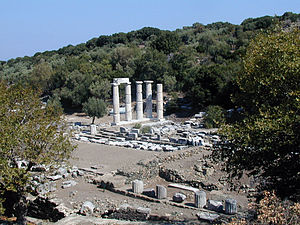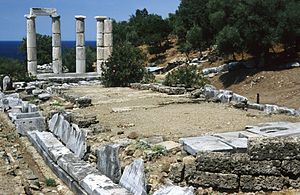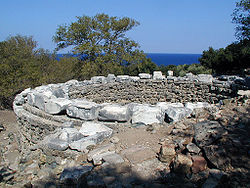Samothrace temple complex
During the Hellenistic period, after the investiture of Phillip II, it formed a Macedonian national sanctuary where the successors to Alexander the Great vied to outdo each other's munificence.The whole of the sanctuary was open to all who wished to worship the Great Gods, although access to buildings consecrated to the mysteries was understood to be reserved for initiates.Prayer and supplications accompanied by blood sacrifices of domestic animals (sheep and pigs) burnt in sacred hearths (εσχάραι eschárai), as well as libations made to the chthonic deities in circular or rectangular ritual pits (βόθρος bóthros).It consisted of the presentation of a sacred play, which entailed a ritual wedding (ιερός γάμος hierós gámos); this may have taken place in the building with the Dancer's Wall which was built in the 4th century BC.In return for this revelation, which was kept secret, the initiate was given the assurance of certain privileges: Hope for a better life, and more particularly protection at sea, and possibly, as at Eleusis, the promise of a happy afterlife.The myesis then took place in the Anaktoron, a large hall capable of accommodating numerous already initiated faithful, who would attend the ceremony seated on benches along the walls.The hierophant (ιεροφάντης hierophántes), otherwise known as the initiator, took his place on a platform (βήμα béma), in the apse where he recited the liturgy and displayed the symbols of the mysteries.The entrance is in the east through the Ptolemy II propylaeum, also known as the Ptolemaion (site plan number 20), which used to span the eastern brook and function as a bridge, until destroyed by an earthquake.Immediately to the west, on the first terrace, there is a somewhat circular paved depression, containing an altar in the centre, which was undoubtedly a sacrificial area; although the precise function of this place has not further been determined.A large tholos, the Arsinoëion, or Arsinoë Rotunda (site plan number 15), the largest covered round space in the ancient Greek world (20 m in diameter), may have served to welcome the theoroi, sacred ambassadors delegated by cities and associations to attend the great festivals at the sanctuary.The Anaktoron, the building for greeting the myesis is located north of the Arsinoë Rotunda, though the version currently visible dates to the imperial era.Overlooking the central terrace, the space is above all dominated by a very large portico (104 m long; site plan number 8) which acts as a monumental backdrop to the sanctuary, above the theatre.And we are told that Philip, after being initiated into the mysteries of Samothrace at the same time with Olympias, he himself being still a youth and she an orphan child, fell in love with her and betrothed himself to her at once with the consent of her brother, Arymbas.The second surge of major construction commence started in the 280s with the Arsinoe II Rotunda, which may date from the period (288–281 BC) when this daughter of Ptolemy I was married to the Diadochus Lysimachus, then king of Macedon.Ptolemy II himself had the Propylaeum built across the entrance to the sanctuary: the powerful Ptolemaic fleet which allowed him to dominate the bulk of the Aegean up to the Thracian coast, and the construction at Samothrace bear witness to his influence.The re-establishment of the Antigonid dynasty on the Macedonian throne with Antigonus II Gonatas, soon led to a clash for maritime supremacy on the Aegean; Antigonus Gonatas celebrated his victory at the naval battle of Kos by dedicating one of his victorious ships to the shrine by 255–245 BC, displayed in a building constructed on an ad hoc basis on the west terrace: the Neorion (site plan number 6).Champoiseau returned in 1891 to look for the blocks which formed the ship's prow upon which the Winged Victory of Samothrace statue had been installed in Paris, and at this time discovered the theatre.









Modern GreekPan-Hellenic religious sanctuariesSamothraceThraceAncient GreeceMystery religionHerodotusSpartanLysanderAtheniansAristophanesHellenistic periodPhillip IIMacedonianAlexander the GreatRoman periodHadrianLate Antiquitypersecution of pagans in the late Roman EmpireCabeiriSite planPantheonchthonicAnatolianPhrygianTrojanMother GoddessMount Idafertility goddessDemeterporphyrynecropolisHecateAphroditeGreeksHermesphallicsymbolsDardanosIasionDioscuriAxiokersosAxiokersaPersephonegoddess of fertilitygod of the underworldEleusisCadmosHarmonyElectrasacrificeslibationsaltarsfestivalsacred playfriezeTemenosDionysiantheatrevotive offeringsEleusinian MysteriesliturgyKrioboliaTauroboliaMagna MaterPtolemy IIpropylaeumArlington Reservoir, MassachusettstholostheoroirotundaArlington Massachusetts ReservoirScopasperipterosprostyleMiletusNeorionByzantineDiodorus SiculusMyrinaCorybantesPlutarchOlympiasEpiroteAeacid dynastyArgead dynastyDiadochiPtolemaic dynastyAntigonid dynastyepigraphicPhilip III of MacedonAlexander IV of MacedonArsinoe IIPtolemy IDiadochusLysimachusPtolemy KeraunosAntigonus II GonatasPhilip V of MacedonthalassocracyRhodesPergamonWinged Victory of SamothracePerseus of MacedonBattle of Pydnathe LouvreLouvreAdrianopleGallipoliIstanbulÉcole française d'AthènesCharles University in PragueInstitute of Fine ArtsNew York UniversityanastylosisAncient Greek religionKarl LehmannTimelineHistoryGeographyCycladic civilizationMinoan civilizationMycenaean GreeceGreek Dark AgesArchaic GreeceClassical Greece